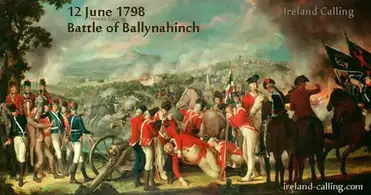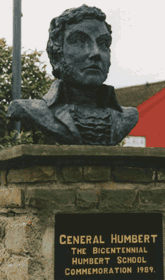
And over the border…
Although Ulster’s fighting capabilities had been hobbled, even decapitated by Lake’s marauding forces prior to the start of the rising, Henry Joy McCracken and Jemmy Hope remained at large and Antrim, focus of all the unrest even when the majority of the country had been at peace, exploded as a centre of the rebellion. Having taken control of the United Irishmen as their Ulster leaders dithered, waiting for help from France, McCracken led the rising, intending to take the government outposts in the county and then move on Antrim Town itself. Then, using artillery captured from Antrim Town, he would lead the rebels in a march to Belfast, in conjunction with the rebels from County Down.
Things went to plan initially, with Larne, Ballymena, Portadown and Randalstown all captured, but on the march to Antrim Town old enmities resurfaced between the Presbyterians and the Catholic Defenders, and many deserted, leaving McCracken with a much smaller force than he had envisaged taking the town with. The resultant delay gave the garrison time to request reinforcements from Belfast, and though again they were outnumbered (only about 200) they also possessed the artillery which eventually proved the rebels’ undoing. Overall they did quite well, and were pushing the British back, but the arrival of a barrage of shells from the newly-arrived reinforcements from Belfast took them by surprise and demoralised them, causing many more to desert and flee. In the face of now overwhelming odds, McCracken and Hope had no choice but to follow them.
In County Down, meanwhile, a force of 1,000 rebels attacked the house of the McKee family, known to be British informers and sympathisers, burned the place to the ground and killed everyone. In response the British sent a somewhat inadequate force of about 300 men to meet them, straight into an ambush. Rather interestingly, where the rudimentary weapons of the rebels had proved a hindrance to them in previous battles, at the Battle of Saintfield, as this skirmish was known, the British (at least, these ones) seemed unfamiliar with the pike, and were not trained to fight against such weapons, being more comfortable shooting muskets and firing artillery, and using swords. Though the artillery was used, to decent effect, all it managed to do was buy the British time to escape.
The next battle though would be a real one, and crucial.

The Battle of Ballynahinch was doomed from the outset. Commanded by a man who had no military training at all, Henry Munro, who had only taken over control of the rebels when their true leader was arrested, and who refused to attack under cover of night because he believed it dishonourable (!), the United Irishmen were pounded into submission by British artillery - those who didn’t slink off at the naivete of their commander, that is. The next morning, Munro’s reticence proved fatal as the British attacked again, this time driving the Irish into full retreat, which they happily turned into a slaughter.
Betsy Gray, of whom we have spoken already, was killed at the Battle of Ballynahinch, and Munro, having trusted - and paid - a local farmer to hide him, was betrayed and then for good effect hanged outside his own house.

For the first and only time in Irish history Catholics and other dissenters had banded together against a common enemy, but the failure of the rebellion, coupled with lingering distrust on both sides which could not be banished, and fanned by the atrocities committed on both sides, meant it would be the last. From here on, Catholics would ply their own path against the repressive British Protestant government, and would receive no further help from Presbyterians or other dissenters.
 LIBERTY, EQUALITY, FRATERNITY, UNION, After several unsuccessful attempts, behold at last Frenchmen arrived amongst you... Union, Liberty, the Irish Republic! Such is our shout. Let us march. Our hearts are devoted to you; our glory is in your happiness
LIBERTY, EQUALITY, FRATERNITY, UNION, After several unsuccessful attempts, behold at last Frenchmen arrived amongst you... Union, Liberty, the Irish Republic! Such is our shout. Let us march. Our hearts are devoted to you; our glory is in your happiness. - General Jean Humbert, August 1978, on landing in Killala.
As Lake was replaced by Lord Cornwallis as commander of Ireland, the long-awaited French help finally arrived. Way too late. Landing at Killala Bay in County Mayo, General Humbert, who had also commanded the ill-fated 1796 attempt at landing in Bantry Bay, brought 3,000 men ashore and was met by Lake, who engaged them at the Battle of Castlebar (not surprisingly, at Castlebar). News of the French landing had given hope to the mostly-beaten United Irishmen, and those who could made their way to Mayo to support the invasion, hoping for a resurgence of the crushed rising. As Humbert and his Irish allies marched towards the town of Castlebar, the British, believing the invaders had only one way to approach, trained their guns on the main Ballina Road. But locals had advised Humbert of an alternative route, and though the British believed it impassable, the rebel force negotiated it and took them by surprise with their guns facing the other way.
The British forces, many of them Yeomanry, used to fighting ill-disciplined and untrained Irish rebels with little idea of tactics or strategy, were outmanoeuvred and unnerved by the French, who knew how to fight a campaign and how to take a town. When Humbert launched a ferocious bayonet charge the gunners panicked and ran, some of the British even defecting to the joint Irish/French side and fighting alongside them. The British are said to have run so fast and so far - although hardly even pursued - that the event became known in Ireland as “The Castlebar Races”. Having thoroughly routed the foe, the Irish rebels declared the Republic of Connaught, a self-contained client state of the French Republic, but like the Republic of Wexford, it would not last long.
Twelve days, in fact. On September 8, a huge force of 10,000 under Cornwallis met Humbert at Ballinamuck (no, really) and this time the superior numbers told. Cornwallis had about 26,000 men to the combined Irish and French strength of just over 2,000, and having crossed the Shannon in the hopes of joining up with rumoured pockets of resistance having sprung up again in Westmeath and Longford - these minor rebellions quickly crushed - Humbert decided to make his stand at Ballinamuck. Lake was closing in behind him, and he knew he was in a desperate situation.
Though there was a force of 3,000 waiting at sea to land once he had achieved his objective, Humbert had come to Ireland on the strength of intelligence that said the country was in revolt, and that the Irish would join him in freeing the country. By the time he had arrived of course, the rising was all but over, and the Irish defeated and on the run, so he was more or less fighting a rearguard action instead of spearheading an invasion. Realising his cause was now doomed, Humbert surrendered after a short fight, and the proposed invasion by France of Ireland, like the Irish rising, was over.